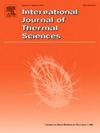气体辐射对密闭腔内湍流热羽流的直接数值模拟
IF 5
2区 工程技术
Q1 ENGINEERING, MECHANICAL
International Journal of Thermal Sciences
Pub Date : 2025-02-24
DOI:10.1016/j.ijthermalsci.2025.109820
引用次数: 0
摘要
采用直接数值模拟的方法,研究了在充满湿空气(空气/水混合物)的立方体空腔中气体辐射对热羽流的影响。在这项工作中,流体中的辐射由Denison和Webb开发的SLW模型考虑,并使用离散坐标法(S8正交)进行数值求解。对含不同水汽量的潮湿空气进行了模拟,并与无辐射的情况进行了比较。考虑了瑞利数的两个值2×106和109,分别对应于稳态和紊流状态。稳态解表明,气体辐射倾向于减少热羽流的空间扩散,使远离热源的温度场均匀化。气体辐射也会导致全球环流的衰减。结果表明,等温壁面上的辐射通量远大于对流通量,且辐射换热仍随水蒸气浓度的增加而增加。对于湍流状态,考虑辐射导致羽流的波动行为减少,并导致除热源周围区域外大部分空腔的平均温度场的全球移动。在平均流场中,热辐射会减弱流动循环强度,但会加速热源上方中心线的流动速度。本文章由计算机程序翻译,如有差异,请以英文原文为准。
Gas radiation effect on a turbulent thermal plume in a confined cavity using direct numerical simulation
Influence of gas radiation on a thermal plume is investigated in a cubical cavity filled with humid air (air/H2O mixture) by means of Direct Numerical Simulation. In this work, radiation within the fluid is considered by the SLW model developed by Denison and Webb and numerically solved using the Discrete Ordinate Method (S8 quadrature). The simulations are conducted for humid air with different amounts of water vapor and compared to the case without radiation. Two values of the Rayleigh numbers, and 109, are considered, corresponding to steady and turbulent flow regimes. Steady solutions show that gas radiation tends to reduce the spatial spreading of the thermal plume and to homogenize the temperature field away from the heat source. Gas radiation also results in an attenuation of the global circulation. It is shown that the radiative fluxes are much higher than convective fluxes on the isothermal walls, and the radiative heat transfer still increases with the water vapor concentration. For the turbulent regime, accounting for radiation leads to a less fluctuating behavior of the plume and induces a global shift of the mean temperature field in most of the cavity, except in the region around the heat source. Regarding the mean flow field, thermal radiation tends to weaken the intensity of flow circulation, but to accelerate the flow velocity along the centerline above the heat source.
求助全文
通过发布文献求助,成功后即可免费获取论文全文。
去求助
来源期刊

International Journal of Thermal Sciences
工程技术-工程:机械
CiteScore
8.10
自引率
11.10%
发文量
531
审稿时长
55 days
期刊介绍:
The International Journal of Thermal Sciences is a journal devoted to the publication of fundamental studies on the physics of transfer processes in general, with an emphasis on thermal aspects and also applied research on various processes, energy systems and the environment. Articles are published in English and French, and are subject to peer review.
The fundamental subjects considered within the scope of the journal are:
* Heat and relevant mass transfer at all scales (nano, micro and macro) and in all types of material (heterogeneous, composites, biological,...) and fluid flow
* Forced, natural or mixed convection in reactive or non-reactive media
* Single or multi–phase fluid flow with or without phase change
* Near–and far–field radiative heat transfer
* Combined modes of heat transfer in complex systems (for example, plasmas, biological, geological,...)
* Multiscale modelling
The applied research topics include:
* Heat exchangers, heat pipes, cooling processes
* Transport phenomena taking place in industrial processes (chemical, food and agricultural, metallurgical, space and aeronautical, automobile industries)
* Nano–and micro–technology for energy, space, biosystems and devices
* Heat transport analysis in advanced systems
* Impact of energy–related processes on environment, and emerging energy systems
The study of thermophysical properties of materials and fluids, thermal measurement techniques, inverse methods, and the developments of experimental methods are within the scope of the International Journal of Thermal Sciences which also covers the modelling, and numerical methods applied to thermal transfer.
 求助内容:
求助内容: 应助结果提醒方式:
应助结果提醒方式:


